Glossary of Printing
Our Custom Offerings
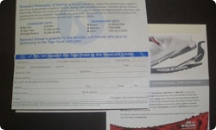
2-Way Remittance
A specialized type of envelope with dual sections designed for secure and organized document and payment exchanges between sender and recipient.
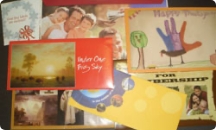
4-Color
A standard method in the printing industry that uses four ink colors to reproduce a wide spectrum of colors and produce full-color images and graphics.
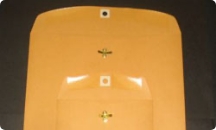
Clasp
A small metal fastener on the flap of an envelope that can be pressed or bent to hold the envelope securely closed.

Colored
An envelope made from paper that is not plain white or cream but comes in various colors.
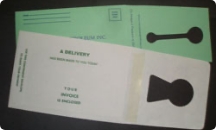
Door Hanger
A printed piece that is designed to hang on a door knob or handle and is often used for advertising, notifications, or informational purposes.
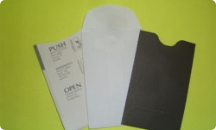
Door Key Or Credit Card
A small envelope designed to securely store and carry door keys or credit cards.

Expansion
The process of adding additional panels or sections to accommodate more content and will expand when filled.
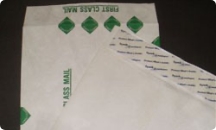
First Class Border With Zipstick
A printed design element, often used for mailings that require a premium or first-class appearance, with a peel-and-seal adhesive strip for convenient sealing.
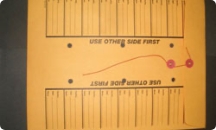
Inner Office Back
The inside or reverse side of an office envelope, which may be used for additional document delivery instruction for offices.
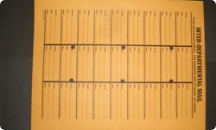
Inner Office Front
The inside or front side of an office envelope, where documents or materials are placed for secure transportation within an office setting.
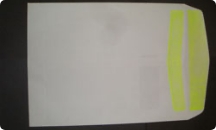
Latex
Self-adhering latex adhesive applied to two surfaces that seals on contact when joined.
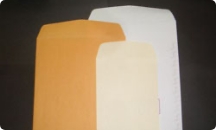
Open End
Style of envelope that opens on the short side (the end) with a center seam.
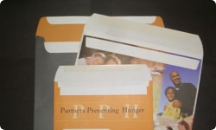
Open Side
Style of envelope that opens on the long side (the side) with two side seams.
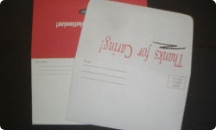
Remittance
Style of envelope allowing donors to conveniently return payments or donations with pre-printed details and a return address.

Security Strip
A protective feature cut into the flap and very easy to determine if seal has been tapered with.
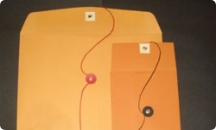
String & Button
A closure mechanism involving a string and button, which is used to secure the envelope’s flap.
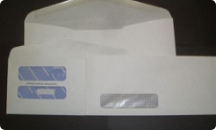
Security Tint
A pattern is printed on the inside of the envelope that makes it hard to see through or distorts text contained inside making it hard to read the contents.

Window
A cut-out in the body of the envelope positioned to show mailing address, return address and/or special messages.

Zipstick
A peel-and-seal adhesive strip on the flap of an envelope, allowing for easy and secure sealing without the need for moisture or additional adhesive.
Our Equipment
Clasp
Applies clasp to premanufactured envelopes for a resealable envelope. Flap is extended.
Didde Web press
Lithographic quality printing up to 4 colors with perforating and numbering capabilities.
Digital press
Quality 4 color CMYK digital printing on premanufactured envelopes and flat sheets.
GTO/RYOBI press
Lithographic quality printing up to 4 colors for flat sheets.
Jet press
Lithographic quality printing on premanufactured envelopes. Up to 2 colors with perfecting capability (both face and back printing.)
Latex
Self-adhering latex adhesive applied to two surfaces that seals on contact when joined. Flap is extended.
MO
Folding machine for large booklet open side and catalog open end envelopes. Prints 2/0 flexo in line. Can apply peel & seal in line. Has multiple window capabilities.
Rotary Automatic (RA)
High speed/capacity folding machine for commercial and small open side envelopes. Has multiple window capabilities. Prints 2/1 flexo in line.
SO
Folding machine for very small open end and open side envelopes. Can apply latex seal gum
Web feed RA
High speed/capacity folding machine for commercial and small open side envelopes. Prints 2/1 flexo in line. Can apply peel & seal in line. Has multiple window capabilities. Web feed gives the option of a lower cost alternative to die cut blanks.
Wide Range
Small run folding machine for commercial and small open side envelopes. Has multiple window capabilities. Versatile for quick set ups on smaller runs.
Common Envelope Terms
A
Adhesives: Latex
Made from rubber-based material for self-seal envelopes. Latex is applied to the seal flap and the back of the envelope and sticks only to itself.
Adhesives: Pressure Sensitive
Applied to the seal flap and covered by release paper: self-sealing. Also referred to as Zip Stick or Peel & Seal.
Adhesives: Remoistenable
Adhesive activated by water or solvent. Applied to the seal flap of envelopes.
Adjustable Die
Adjustable die cutting method designed to cut envelope blanks utilizing a system of movable blades. This is a cost effective way to die cut without purchasing a new envelope die.
B
Bang-tail
A style of envelope with a perforated coupon attached to the body of a return envelope. This portion must be torn off before the envelope is sealed. Used for remittance envelopes, order envelopes and other direct response mail pieces.
Baronial
A type of envelope recognized by large pointed flap.
Blank
A die-cut out of a sheet of paper before it is folded into an envelope.
Bleed
A printed image that extends beyond the fold of the envelope or the edge of the page.
Booklet
An open side, double side seam envelope that opens on the long dimension.
Business Reply Envelopes (BRE)
Specially printed envelopes that may be mailed without prepayment of postage. The postage and fees are collected from the permit holder when the mail is delivered back to the sender.
C
Catalog
An open end center seam envelope that opens on the short dimension
Center Seam
An envelope style where the sides are folded and glued over each other, forming a seam that runs down the center of the envelope.
Closed Face
An envelope without a die cut window.
Commercial
Open side, diagonal or side seam envelope with commercial style flap.
Converting only
Paper is supplied by the customer for conversion into an envelope.
Corner Card:
A term used to reference printing of the return address only usually located in the upper left hand corner of an envelope.
Courtesy Reply Envelope (CRE)
You pay only for the cost of envelopes. Your customer pays the postage, and no permit is required to send CRE mail. You can expedite returns by having pre-addressed and pre-barcoded envelopes.
D
Diagonal Seam
A seam running diagonally from the bottom fold upward toward the throat of the envelope.
Die
A precision tool used to cut out envelope blanks, windows or other shapes.
E
Expansion Envelope
An envelope with a gusset allowing it to expand for bulky mailings.
Expansion Score
An additional score on the seal flap to accommodate bulky contents.
F
First Class Mailer
An envelope with a pre-printed diamond shaped border around its perimeter. A break in the border is left in the upper right hand corner for postage. The words “FIRST CLASS” are normally pre-printed on the face and seal flap, but are not required. The most common color used in printing the border is green.
Flaps Extended
A term used to describe envelopes with their flaps open and extended.
Full View
A Full View envelope has an extra large window designed to give maximum exposure to the contents. Especially valuable for attracting attention and enhancing response to direct mail advertising.
G
Grain
Direction in which most of the fibers lie in a finished sheet of paper. Paper folds more easily and with less waist, when folding with the grain.
H
Hobbs Die Cutting
A precision cutting process that uses adjustable blades to cut paper into envelope blanks for folding.
I
Inside Tint
A design printed on the inside of the envelope used for added security.
Indicia
Mailing permits that are printed on an envelope where a stamp would normally be placed indicating the sender will pay the postage.
O
Opacity
Paper property that measures the degree to which paper stops light from passing through. Inside tints can be used to compensate for low-opacity papers.
Open-End
Style of envelope in which the opening is on the shorter side.
Open-Side
Style of envelope in which the opening is on the longer side.
P
Patch Material
Refers to the EZC material used to cover envelope windows.
PMS (Pantone Matching System)
A popular color matching system used by the printing industry to print spot colors allowing you to specify colors by indicating the Pantone name or number. This assures that you get the right color when the file is printed.
Printing
The choice of a printing process depends upon several factors. Some of which include the quantity, complexity and characteristics of the artwork, number of ink colors, as well as paper stock and the level of desired quality of finished product.
Printing: Flexography
(Also called Flexo printing) A form of printing using flexible rubber or photopolymer plates. Most common type of envelope printing, fast drying process, suitable for screens with 65-105 lines. Printed in line at the same time envelope is converted. Simplified art generally preferred. Usually, this method is most cost effective for larger quantities.
Printing: Jet
Prints converted envelopes; equipment varies from 1 to 4 colors, 1 or 2-sided. Fast turn times, good quality, and economical pricing.
Printing: Lithography
(Also known as FLAT SHEET LITHO or OFFSET PRINTING) Offers highest degree of precision, clarity and quality, uses screens of 133 lines or more.
Proof
A proof is a preliminary view of what is be printed. It will show text, fonts, images, colors, size and location of what is to print.
S
Split Seal Gum
Gum pattern on seal flap when envelopes are to be used on automatic inserting equipment. Gum is broken where flap covers envelope at seams; prevents flap from sticking to the back panel.
String-and-Button
A custom closure with a string attached to the flap and a button on the body of the envelope.
T
Thumb Cut
Found on envelopes manufactured without flaps, such as filing and film storage. Can be cut on one side or double thumb cut, for easier extraction of contents.
Tyvek®
Spun bonded olefin product manufactured by DuPont. Offers maximum protection and durability at a very light weight. Tyvek® is unaffected by moisture and inert to most chemicals. Acid, lint and sulfide free.
W
Window
A cut-out in the body of the envelope positioned to show mailing address, return address and/or special messages.
Window Position
Location of the window on the envelope, as measured from the left and bottom edges of the envelope. Window edge should be no closer than 3/8” from any edge to allow space for gluing window material in place. Note: Window dimensions are always indicated with the height dimension listed first and the width dimension listed second.
Wove
Paper having uniform surface and no discernible marks. Soft, smooth finish. Most widely used envelope paper. Lower in opacity, brightness and bulk. Available in white or colors.

